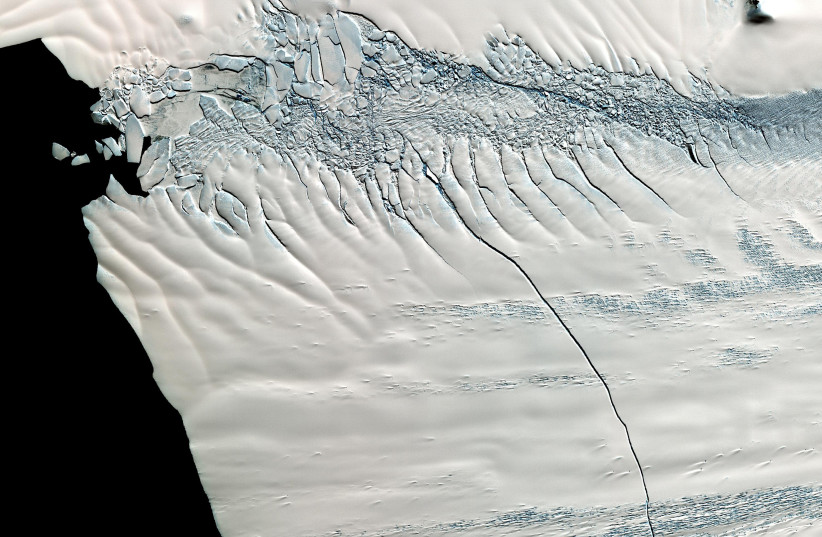The Amundsen Sea Embayment, the fastest-changing Antarctic region, has lost over three trillion tons of ice over the span of 25 years, scientists in England found in a study published last week.
The findings were published in a new peer-reviewed study published in Nature journal.
In the study, the scientists, led by Dr. Benjamin Davison, a Research Fellow at the Institute for Climate and Atmospheric Science at the University of Leeds, calculated the “mass balance” - the balance between the mass of snow and ice gain due to snowfall and mass lost through calving - of the Amundsen Sea Embayment, which is part of the West Antarctic Ice Sheet.
Calving is the process by which an iceberg forms at the end of a glacier and drifts out to sea.
“Whilst grounding line discharge from the ASE [Amundsen Sea Embayment] glaciers has, other than a short hiatus around 2012, progressively increased since 1996, their mass balance has been more variable over the 25-year study period because of large variations in SMB [surface mass balance] over seasonal to multi-year timescales,” the researchers noted.

“We note that the mass balance of the ASE glaciers in 2021 was the lowest on record at −235 ± 68 Gt yr−1, due to both increasing grounding line discharge since late-2017 and low snowfall during the 2021 winter.”
20 major glaciers in the embayment - which is four times larger than the United Kingdom - are major contributors to global sea levels.
“Scientists are monitoring what is happening in the Amundsen Sea Embayment because of the crucial role it plays in sea-level rise. If ocean levels were to rise significantly in future years, there are communities around the world who would experience extreme flooding.”
Dr. Benjamin Davison, Research Fellow, Institute for Climate and Atmospheric Science, University of Leeds
The snow and ice in the embayment contain enough water that if it were to drain into the sea, global sea levels would rise by over a meter.
When calving occurs at a faster rate than that at which the ice is replaced by snowfall, the embayment loses mass, contributing to sea level rise.
The researchers found that West Antarctica lost 3,331 billion tons of ice between 1996 and 2021, causing global sea levels to increase by over nine millimeters. The most significant factors driving the loss of ice are believed to be changes in ocean temperature and currents.
“The 20 glaciers in West Antarctica have lost an awful lot of ice over the last quarter of a century and there is no sign that the process is going to reverse anytime soon although there were periods where the rate of mass loss did ease slightly,” said Dr. Davison, a Research Fellow at the Institute for Climate and Atmospheric Science at Leeds.
“Scientists are monitoring what is happening in the Amundsen Sea Embayment because of the crucial role it plays in sea-level rise. If ocean levels were to rise significantly in future years, there are communities around the world who would experience extreme flooding.”
Extreme snowfall events
Using climate models showing how air currents move around the world, the scientists found that the embayment experienced multiple extreme snowfall events over the 25-year duration of the study. These events would have resulted in periods of heavy snowfall and periods of very little snowfall, or "snow drought."
Accounting for extreme snowfall events in their calculations, the researchers found that these events contributed up to half of the ice sheet change at times, playing a major role in the contribution of the embayment to sea level rise.
For instance, the models showed a period of snow drought between 2009 and 2013 that starved the ice sheet and caused it to lose ice, contributing about 25% more to sea level rise than in years of average snowfall.
The models also showed that there was a period of very heavy snowfall during the winters of 2019 and 2020, which the scientists believe mitigated the sea level contribution of the Amundsen Sea Embayment by about half of what it would have been in an average year.
Over the course of the study, the Pine Island Glacier retreated and one of its tributary glaciers - named Piglet Glacier by the UK Antarctic Place-names Committee - became detached and accelerated rapidly.
“As well as shedding new light on the role of extreme snowfall variability on ice sheet mass changes, this research also provides new estimates of how quickly this important region of Antarctica is contributing to sea level rise,” said study co-author Dr. Anna Hogg, an associate professor at the Institute of Climate and Atmospheric Science at the University of Leeds.
“Satellite observations have showed that the newly named Piglet Glacier accelerated its ice speed by 40%, as the larger PIG retreated to its smallest extent since records began.”
Using satellites such as the European Space Agency's Copernicus Sentinel-1 satellite, which is equipped with sensors that can “see” through clouds even at night, scientists are now able to monitor remote regions and the rapid changes currently occurring in Antarctica.
